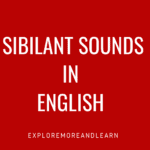Sibilant sound is produced by forcing air out toward your teeth.
Like: hissing sound (sssss),
a buzzing sound (zzzzz) or
(shhhh!) Sound which you make to keep someone quiet.
Sibilant, in phonetics, a fricative consonant sound, in which the tip, or blade, of the tongue is brought near the roof of the mouth and air is pushed past the tongue to make a hissing sound. In English s, z, sh, and zh (the sound of the s in “vision”) are sibilants. Sometimes ch and j are also considered as sibilant sounds.
The symbols in the International Phonetic Alphabet used to denote the sibilant sounds are, respectively, [s] [z] [ʃ] [ʒ] [tʃ] and [dʒ].
Examples of sibilants are the consonants at the beginning
Sip, Seed, Seat, (Sibilant s /s/)
zip, zoo, zone, (Sibilant z /z/ )
ship, she, show (Sibilant sh /ʃ/ )
Genre. Georges (Sibilant zh /ʒ/)
Chin, chair, chalk (Sibilant ch /tʃ/)
Jug, Just, Jeep (Sibilant J /dʒ/ )
Examples of sibilant sounds in the middle
Task, Risk, Dust (Sibilant s /s/)
Caution, Fashion, washing (Sibilant sh /ʃ/ )
Size, citizen, freezing (Sibilant z /z/ )
Usual, Vision, Visual ( Sibilant zh /ʒ/ )
Teaching, Kitchen, Stretching (Sibilant ch /tʃ/ )
Judgement, Suggestion, Region (Sibilant J /dʒ/ )
Sibilant Sounds in the end
Press, Kiss, Guess (Sibilant s /s/)
Dish, Fish, Flourish (Sibilant sh /ʃ/ )
Rose, Shows, Cheese (Sibilant z /z/ )
Beige, Massage, Garage (Sibilant zh /ʒ/ )
Catch, Branch, Bench ( Sibilant ch /tʃ/ )
Strange, Change, Judge (Sibilant J /dʒ/ )
To understand these sound symbols between the slashes, click here.
Read about voiced and voiceless sounds.
- Simple Present Tense Rules with Examples
- 10 Useful Idioms with Meaning and Examples
- Various Ways to Make Requests
- Prepositions Test with Answers
- Collocations in English
- Whose vs Who’s
- Using Idioms and Expressions in Everyday Conversations
- Daily Use Sentences in Hindi to English
- Techniques to Improve English Vocabulary
- Its and It’s Worksheet

